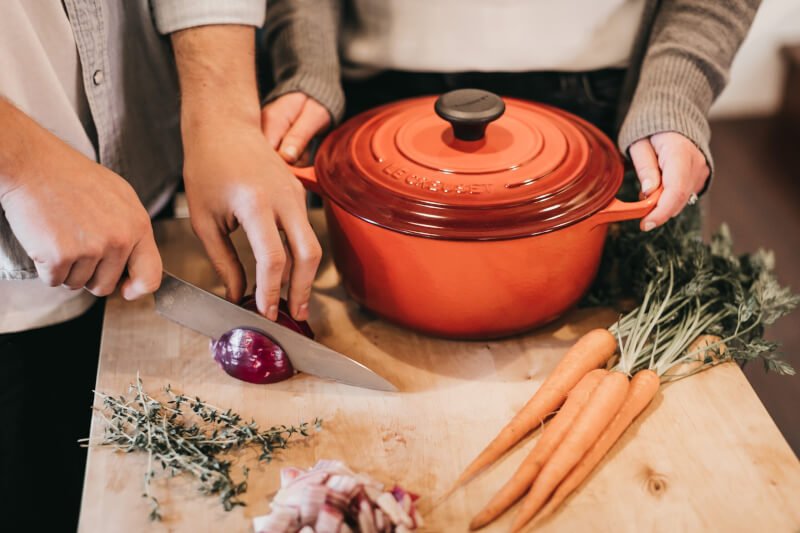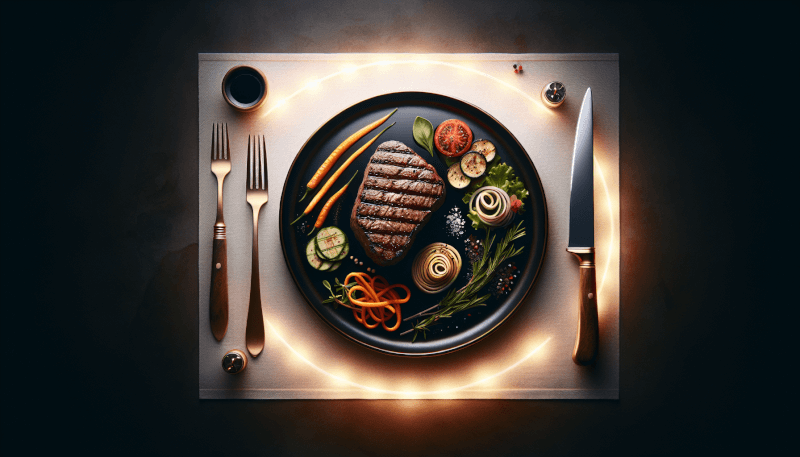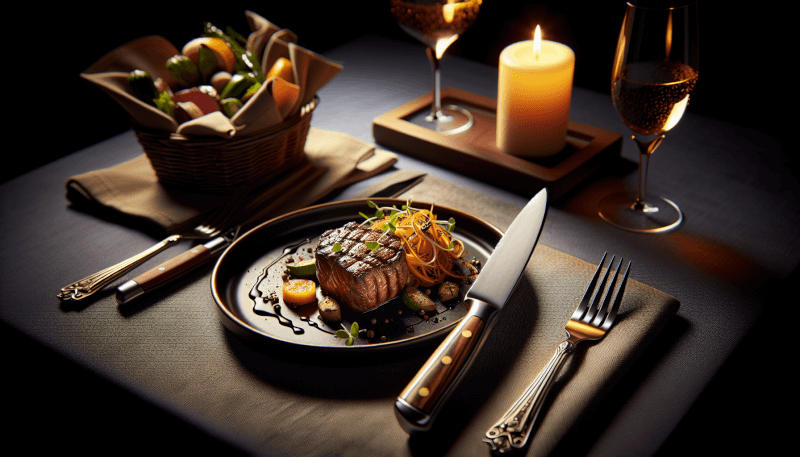Imagine sitting in a cozy restaurant, ready to indulge in a succulent steak that promises to melt in your mouth. As you eagerly wait for your dish to arrive, you can’t help but wonder about the role of that sleek, sharp utensil by your side – the steak knife. With its refined edge and impeccable design, it seems to hold a significance beyond its mere functionality. In this article, we will explore the pivotal role of a steak knife in enhancing your dining experience, from effortlessly slicing through tender cuts of meat to providing a sense of elegance and precision to your meal. Get ready to uncover the secrets behind this essential tool and learn how it adds that perfect touch to your culinary adventures.

The Importance of a Steak Knife
When it comes to enjoying a delicious steak dinner, the right utensils can make all the difference. That’s where the steak knife comes in. Not only does it enhance the dining experience, but it also ensures precise and effortless cuts, minimizes spillage and mess, and adds an elegant touch to the table setting. Let’s dive deeper into these reasons why a steak knife is a must-have tool for any steak lover.
Enhancing the Dining Experience
Imagine sitting down to enjoy a beautifully cooked steak, only to struggle with a dull or inadequate knife. It can quickly ruin the whole dining experience. A good quality steak knife allows you to slice through your steak effortlessly, enhancing the enjoyment of each bite. Its sharpness ensures that you can easily cut through even the most tender cuts of meat, allowing you to savor the flavors and textures without any hindrance.
Ensuring Precise and Effortless Cuts
One of the key advantages of a steak knife is its ability to provide precise and effortless cuts. Unlike standard table knives, steak knives are specifically designed to effortlessly glide through even the toughest cuts of meat, such as ribeye or filet mignon. The sharp, serrated edge or straight blade design enables you to slice through the steak with minimal effort, ensuring each cut is clean and well-defined.
Minimizing Spillage and Mess
Using a steak knife not only ensures precise cuts but also minimizes spillage and mess on the plate. When you use a regular table knife, you may find yourself using more force to cut through the meat, causing juices to flow out and potentially creating a mess. A steak knife’s sharp blade reduces the likelihood of this happening, resulting in a neater and more enjoyable dining experience.
Adding an Elegant Touch to the Table Setting
Apart from their functionality, steak knives also add an elegant touch to the table setting. With their sleek design and often featuring high-quality materials, they elevate the overall aesthetics of the dining experience. A well-placed steak knife complements the other utensils and tableware, creating a visually appealing presentation that adds sophistication to any meal.
Different Types of Steak Knives
Steak knives come in various types, each designed to cater to different preferences and cutting styles. Understanding the differences between these types will help you choose the perfect steak knife for your needs.
Traditional Straight-Edged Knives
Traditional straight-edged steak knives are known for their clean and sharp blades. These knives typically have a smooth, non-serrated edge, making them ideal for individuals who prefer precise, clean cuts. The straight edge allows for greater control and can effortlessly glide through any type of steak. However, they may require more frequent sharpening to maintain their optimum cutting performance.
Serrated Knives
Serrated steak knives feature a saw-like edge, with small teeth along the blade. These teeth grip the meat, making it easier to cut through tough and fibrous cuts. Serrated knives are known for their long-lasting sharpness, as the teeth tend to stay sharp for longer periods. They are a popular choice for those who prefer a more aggressive cutting style or frequently dine on steaks with thicker cuts.
Micro-serrated Knives
Micro-serrated steak knives provide the benefits of both traditional straight-edged and serrated knives. These knives feature small, fine serrations along the blade, allowing for clean, precise cuts while providing extra grip on tough cuts. The micro-serrations help maintain the knife’s sharpness for longer durations, reducing the need for frequent sharpening. Micro-serrated knives are a versatile choice, suitable for a variety of steak cuts and dining preferences.

Choosing the Right Steak Knife
When it comes to selecting the perfect steak knife, you should consider several factors to ensure optimal performance and satisfaction.
Consider the Blade Material
The blade material plays a crucial role in the knife’s overall performance and durability. Common materials used for steak knife blades include stainless steel, high-carbon steel, and ceramic. Stainless steel blades offer durability, corrosion resistance, and ease of maintenance. High-carbon steel blades provide exceptional sharpness and edge retention but require regular maintenance to prevent rust. Ceramic blades offer superb sharpness, lightweight design, and resistance to staining. However, they may be more prone to chipping or breakage if mishandled.
Evaluate the Handle Design
The handle design of a steak knife greatly impacts comfort, grip, and overall maneuverability. Look for handles that provide a secure and ergonomic grip, helping prevent accidental slips and fatigue during use. Common handle materials include wood, stainless steel, and synthetic materials. Wooden handles offer a traditional and warm feel, while stainless steel handles provide a sleek and modern appearance. Synthetic materials such as resin or composite offer durability, flexibility, and often come in various colors and styles.
Examine the Knife’s Weight and Balance
The weight and balance of a steak knife can affect its overall performance and ease of use. A well-balanced knife ensures a comfortable and controlled cutting experience. Some individuals prefer heavier knives, as they provide more stability and require less effort for cutting, while others may prefer lighter knives for increased maneuverability and precision. Consider experimenting with different weights and balances to find the perfect match for your cutting style and preferences.
Factors to Consider for Optimal Performance
To ensure optimal performance and satisfaction with your steak knife, consider the following factors:
Sharpness of the Blade
The sharpness of the blade is crucial for effortless and precise cuts. A dull blade can make cutting through steaks challenging and can result in ragged edges or torn meat. Look for steak knives with consistently sharp blades or opt for knives with a reputation for maintaining their sharpness over time. Regular maintenance, such as honing and sharpening, will also help ensure the longevity of the blade’s sharpness.
Ergonomics and Comfort
A steak knife should feel comfortable in your hand, allowing for a secure and ergonomic grip. Consider the size and shape of the handle, as well as any texture or contours that enhance grip and reduce strain. When choosing a steak knife, try holding it in your hand to assess how it feels and how easy it is to maneuver. Investing in a knife that feels comfortable and natural in your hand will enhance your overall dining experience.
Maintenance and Longevity
Consider the maintenance requirements and longevity of the steak knife before making a purchase. Some knives require regular sharpening or honing to maintain their performance, while others are designed to maintain their sharpness for extended periods. Take into account your willingness to invest time and effort into maintaining the knife, as well as the knife’s expected longevity. Quality steak knives often come with care instructions, so be sure to follow them for optimal performance and longevity.

Steak Knife Techniques
Now that you have the perfect steak knife, it’s time to explore some essential techniques that will enhance your cutting skills and elevate your dining experience.
Grip and Hold
Start by holding the steak knife in a firm but comfortable grip. Wrap your hand around the handle, ensuring your thumb rests on the side of the handle opposite the blade. This grip provides better control and stability while cutting through the steak. Experiment with different hand positions until you find the grip that feels most comfortable and secure for you.
Proper Cutting Motion
When cutting through a steak, use a steady and controlled cutting motion. Begin by placing the knife near the edge of the steak and apply gentle pressure as you push the blade forward. Avoid using a sawing motion, as this can lead to uneven cuts or tear the meat. Instead, aim for a smooth, continuous slicing motion that ensures each cut is clean and precise.
Use of a Fork
Using a fork in conjunction with your steak knife can further enhance your dining experience. As you cut a piece of steak, use the fork to secure it in place, preventing it from sliding or moving around the plate. This technique not only allows for better control while cutting but also ensures that each bite is easy to pick up and enjoy.
Proper Care and Maintenance
To prolong the lifespan of your steak knives and maintain their optimum performance, it’s essential to follow proper care and maintenance practices.
Handwashing vs Dishwasher
While it may be tempting to toss your steak knives into the dishwasher for convenience, handwashing is the preferred method for cleaning these delicate blades. Dishwashers can expose the knives to extreme temperatures, harsh detergents, and the risk of clashing against other utensils, damaging the blade or handle. Gentle handwashing with warm water and a mild detergent ensures a thorough yet safe cleaning process. Remember to dry the blades immediately after washing to prevent any potential corrosion.
Sharpening and Honing
To maintain the sharpness of your steak knife blades, regular sharpening and honing are essential. Sharpening removes any dullness or imperfections on the blade, while honing realigns the edge, keeping it razor-sharp. Depending on the type of steak knife, you may need to use a sharpening stone, a honing rod, or seek professional assistance for these processes. Follow the manufacturer’s recommendations or consult a professional to ensure the correct sharpening and honing techniques are applied.
Storage Tips
Proper storage is crucial to protect your steak knives from damage and ensure their longevity. Avoid storing them loosely in drawers or mixed with other utensils that can potentially collide and dull the blades. Instead, consider using a designated knife block or a magnetic knife strip to keep the knives safely secured and easily accessible. Alternatively, knife rolls or sheaths can be used for storage and transport, providing additional protection against scratches and other damage.

Popular Steak Knife Brands
While you have an abundance of options when it comes to choosing steak knives, some brands have gained a reputation for their exceptional quality and craftsmanship. Here are a few popular steak knife brands to consider:
Wüsthof
Wüsthof is renowned for its precision craftsmanship and produces a wide range of high-quality cutlery, including steak knives. Their knives are known for their sharpness, durability, and ergonomic designs.
Henckels
Henckels is a well-respected German cutlery brand offering a variety of steak knives to suit different preferences. Their knives are crafted with precision and innovative technologies, ensuring excellent cutting performance.
Victorinox
Victorinox is a Swiss brand known for its expertise in crafting high-quality knives. Their steak knives feature sharp blades and durable handles, designed to enhance both functionality and aesthetics.
Shun
Shun specializes in premium Japanese cutlery, combining traditional craftsmanship with modern techniques. Their steak knives feature high-quality materials and meticulous attention to detail, resulting in exceptional performance and elegance.
Laguiole
Laguiole is a French cutlery brand known for its handcrafted steak knives that exude elegance and sophistication. With striking designs and exceptional craftsmanship, Laguiole knives are both functional and visually stunning.
Beyond Steak: Other Uses for Steak Knives
While steak knives are specifically designed for cutting through steak, their versatility extends beyond meat. Here are a few other uses for steak knives:
Cutting Through Thick Skinned Fruits
Steak knives can come in handy when slicing through fruits with thick or tough skins, such as melons, pineapples, or mangoes. The sharp blades are capable of effortlessly piercing through the skin, allowing you to create neat and even slices.
Slicing Through Crusty Breads
The serrated edges of steak knives make them ideal for slicing through crusty bread and baguettes. The teeth of the knife grip onto the crust, allowing for clean and even cuts without crushing the delicate interior.
Carving Roasts and Poultry
When it comes to carving roasts or poultry, steak knives can be a valuable tool. Their sharpness and precise cutting action make them suitable for slicing meat with ease, ensuring beautiful and evenly portioned servings.

Tips for Etiquette and Presentation
Proper etiquette and presentation play a significant role in creating an enjoyable dining experience. When it comes to steak knives, keep the following tips in mind:
Proper Placement and Setting
When setting a table, place the steak knives on the right side of the plate, with the blade facing inward towards the plate. Ensure that each knife is aligned with the other utensils, maintaining a visually pleasing symmetry. This will enhance the overall presentation of the table setting.
Using the Steak Knife Responsibly
Use the steak knife responsibly by cutting your steak in a calm and controlled manner. Avoid making unnecessary noise or gestures that may distract or disturb the other diners. Show respect for the meal and those around you by using the knife only for its intended purpose.
Stacking and Positioning the Knives
When clearing the table, stack the steak knives neatly on the plate, with the blade facing inward. This prevents accidental cuts or damage during clearing and ensures a safe and organized cleanup process. Placing the knives at the edge of the plate also signals to the waitstaff that you have finished with the knife.
The Future of Steak Knives
As technology and design continue to advance, the future of steak knives holds exciting possibilities. Here are a few trends and innovations to look out for:
Advancements in Blade Technology
With ongoing research and development, blade technology continues to improve. Innovations such as new alloys, edge retention technologies, and sharper cutting angles may lead to even more efficient and durable steak knives in the future. Keep an eye out for new advancements that can enhance your dining experience.
Innovative Handle Designs
Handle designs are also experiencing innovation, with brands experimenting with different materials, textures, and shapes. Future designs may include ergonomic grips tailored to individual hand sizes or even smart handles with integrated sensors for improved control and feedback during cutting.
Sustainable and Eco-friendly Options
An increasing focus on sustainability and environmental consciousness may result in a rise in eco-friendly steak knife options. Manufacturers may explore using more sustainable materials, such as recycled or biodegradable materials, in both the blade and handle construction. Look for brands that prioritize eco-friendly practices as they pave the way for a greener future.
In conclusion, a steak knife is an essential tool that enhances the dining experience by ensuring precise and effortless cuts, minimizing spillage and mess, and adding an elegant touch to the table setting. With different types to choose from and factors to consider, selecting the right steak knife requires careful evaluation of blade material, handle design, and weight balance. By implementing proper care and maintenance techniques and mastering steak knife techniques, you can prolong the lifespan and optimize the performance of your knives. Additionally, steak knives can be used for various other purposes, such as cutting fruits and slicing bread, expanding their functionality beyond steak. Lastly, proper etiquette and presentation contribute to a refined dining experience, and the future of steak knives holds exciting advancements in blade technology, handle designs, and sustainability. So, next time you sit down to enjoy a juicy steak, make sure you have the perfect steak knife by your side to elevate your dining experience to new heights.


